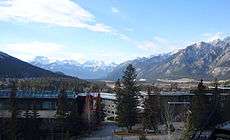Banff Centre
 | |
| Motto | Inspiring Creativity |
|---|---|
| Type | Arts, cultural, and educational institution and conference complex |
| Established | 1933 |
Academic affiliation | University of Calgary |
| President | Janice Price |
| Location | Banff, Alberta, Canada |
| Campus | Tunnel Mountain in Banff National Park |
| Website | banffcentre.ca |
Banff Centre for Arts and Creativity, formerly known as The Banff Centre (and previously The Banff Centre for Continuing Education), located in Banff, Alberta, was established in 1933 as the Banff School of Drama. It was granted full autonomy as a non-degree granting post-secondary educational institution in 1978. It offers arts programs in the performing and fine arts, as well as leadership training.[1] Banff Centre is a member of the Alberta Rural Development Network.[2]
On June 23, 2016, Banff Centre announced a new name and released a new brand identity and strategic plan. It is now called Banff Centre for Arts and Creativity,[3] and its new mission is "to inspire artists and leaders to make their unique contribution to society."[4]
History
The Centre was founded in 1933 by the University of Alberta,[5] with a grant from the U.S.-based Carnegie Foundation. Initially only drama courses were offered. In 1935 the Centre became known as The Banff School of Fine Arts. As arts programming continued to succeed and develop, conferences were introduced in 1953 and management programs in 1954. The facility was renamed The Banff Centre for Continuing Education (The Banff Centre for short) in 1970. The Centre was granted full autonomy as a non-degree granting educational institution under the governance of a board of directors by the Province of Alberta in 1978.
The Centre is now affiliated with the University of Calgary, which became its trustee and a significant student feeder in 1966.
In the mid-1990s, in response to a cut in its provincial operating grant, the Centre launched a capital campaign (The Creative Edge). Proceeds were used to develop conference and arts facilities, which opened in 1996. The Centre was designated as a National Training Institute by the federal government in 1999, and became home the Banff International Research Station in 2003. The Centre's name was officially changed to "The Banff Centre" in 2008, and to the "Banff Centre for Arts and Creativity" in 2016.[1]
Programming
Programs include residencies, workshops, practicum programs, the Leighton Artists’ Colony (an artist retreat), and the multidisciplinary Banff Summer Arts Festival.
- Creative Residencies artist-in-residence programs
- Thematic residencies
- Banff Artist in Residence programs
- Film and media
- Visual arts
- Theatre arts
- Music and sound
- Literary arts
- Indigenous arts
- Leighton Artists’ Colony
- Leadership development
- Dissemination
Facilities
Banff Centre for Arts and Creativity facilities offer a range of resources to support artists across all disciplines. The writers’ lounge serves as a literary conversation hub, while the Library and Archives house a collection of materials with a focus on the visual and performing arts. Tucked away in the forest on campus, the Leighton Artists’ Colony has nine studio cottages to inspire artistic practice with opportunities to interact with the larger Banff Centre community.
In addition to its arts programming, conferences were introduced in 1953 and management programs in 1954. Banff Centre hosts 500 conferences a year, with proceeds dedicated to supporting arts programming. In 2003, it became host to the Banff International Research Station for Mathematical Innovation and Discovery.
References
- 1 2 "History of Banff Centre for Arts and Creativity". Banff Centre. Retrieved 1 July 2016.
- ↑ "List of sponsors". Alberta Rural Education Symposium. Retrieved 1 July 2016.
- ↑ "The Creative Voice: Our Strategic Plan 2016–2021". Banff Centre. 8 June 2016. Retrieved 1 July 2016.
- ↑ "Mission / Vision". Banff Centre. 2016. Retrieved 1 July 2016.
- ↑ Colombo, John Robert (1984). Canadian Literary Landmarks. Willowdale, Ontario, Canada: Hounslow Press. p. 247. ISBN 0-88882-073-9.
External links
- Banff Centre – official site
- Banff International Research Station for Mathematical Innovation and Discovery – official site
Coordinates: 51°10′19″N 115°33′42″W / 51.171843°N 115.561677°W